SM0269: Assessing Indonesian Retail Market Using Porter’s Diamond
VerifiedAdded on 2023/06/10
|22
|5309
|250
Report
AI Summary
This report provides an analysis of the Indonesian retail market for a European company considering overseas expansion. It employs Porter's National Diamond Model to evaluate the competitiveness and investment attractiveness of the Indonesian retail industry. The analysis covers demand conditions, including the influence of a growing middle-class population and changing consumer habits, factor conditions such as labor force participation and capital formation, firm strategy, rivalry, and structure, considering various retail formats and key players, and the role of the government. The report also addresses potential problems in the institutional environment and management issues for venturing into the Indonesian retail market. Sales figures, population demographics, labor force data, and capital formation trends are presented to support the analysis.
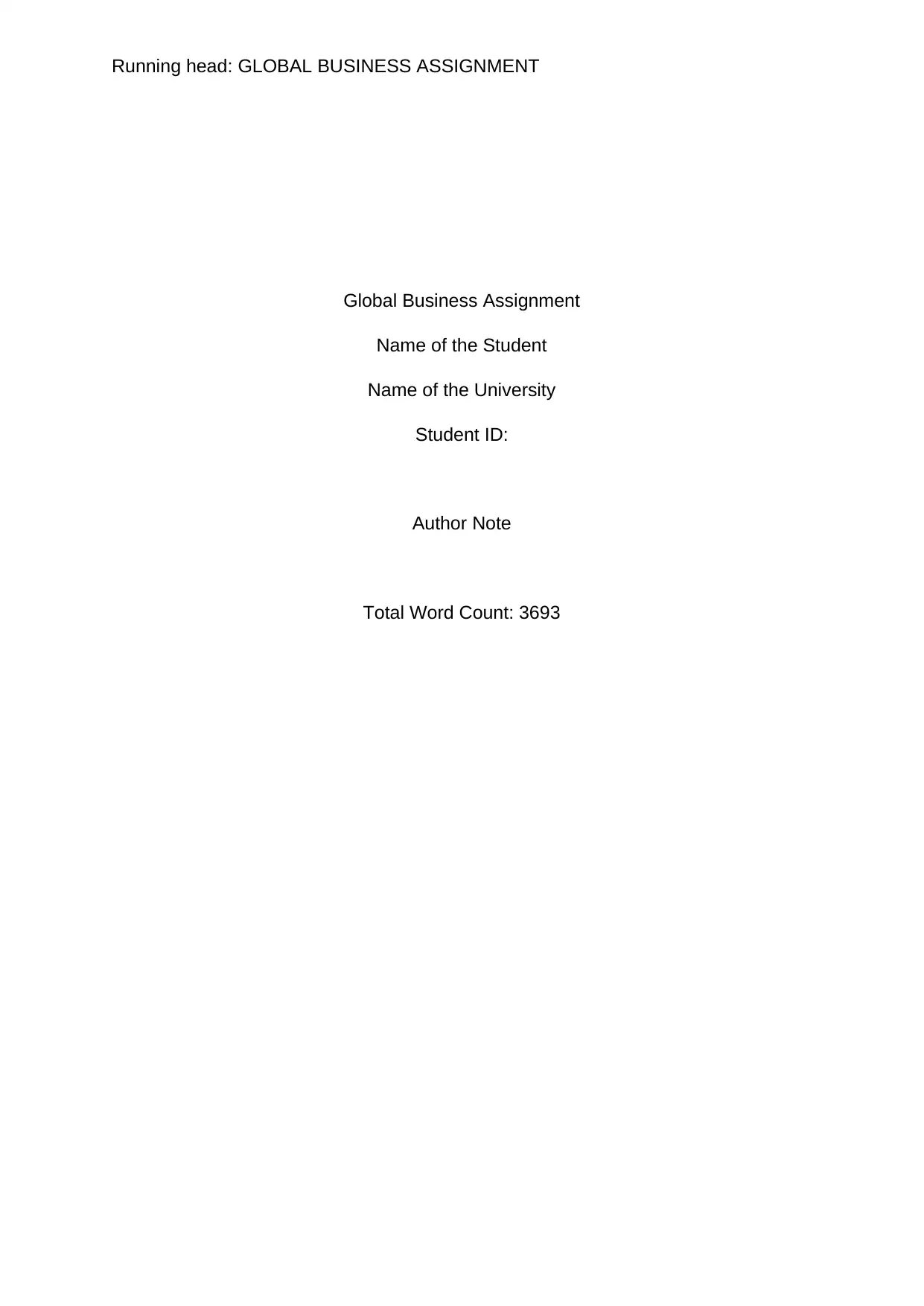
Running head: GLOBAL BUSINESS ASSIGNMENT
Global Business Assignment
Name of the Student
Name of the University
Student ID:
Author Note
Total Word Count: 3693
Global Business Assignment
Name of the Student
Name of the University
Student ID:
Author Note
Total Word Count: 3693
Paraphrase This Document
Need a fresh take? Get an instant paraphrase of this document with our AI Paraphraser

1GLOBAL BUSINESS ASSIGNMENT
Table of Contents
Part 1: Porter’s National Diamond Analysis.................................................................2
Porter’s Diamond Model: Indonesian Retail Market.................................................4
Part 2: Market Entry for Indonesian Retail Market.....................................................13
Problems in the institutional environment in Indonesia..........................................13
Part 3: Management issues in venturing in Indonesian Retail Market.......................16
References.................................................................................................................18
Table of Contents
Part 1: Porter’s National Diamond Analysis.................................................................2
Porter’s Diamond Model: Indonesian Retail Market.................................................4
Part 2: Market Entry for Indonesian Retail Market.....................................................13
Problems in the institutional environment in Indonesia..........................................13
Part 3: Management issues in venturing in Indonesian Retail Market.......................16
References.................................................................................................................18
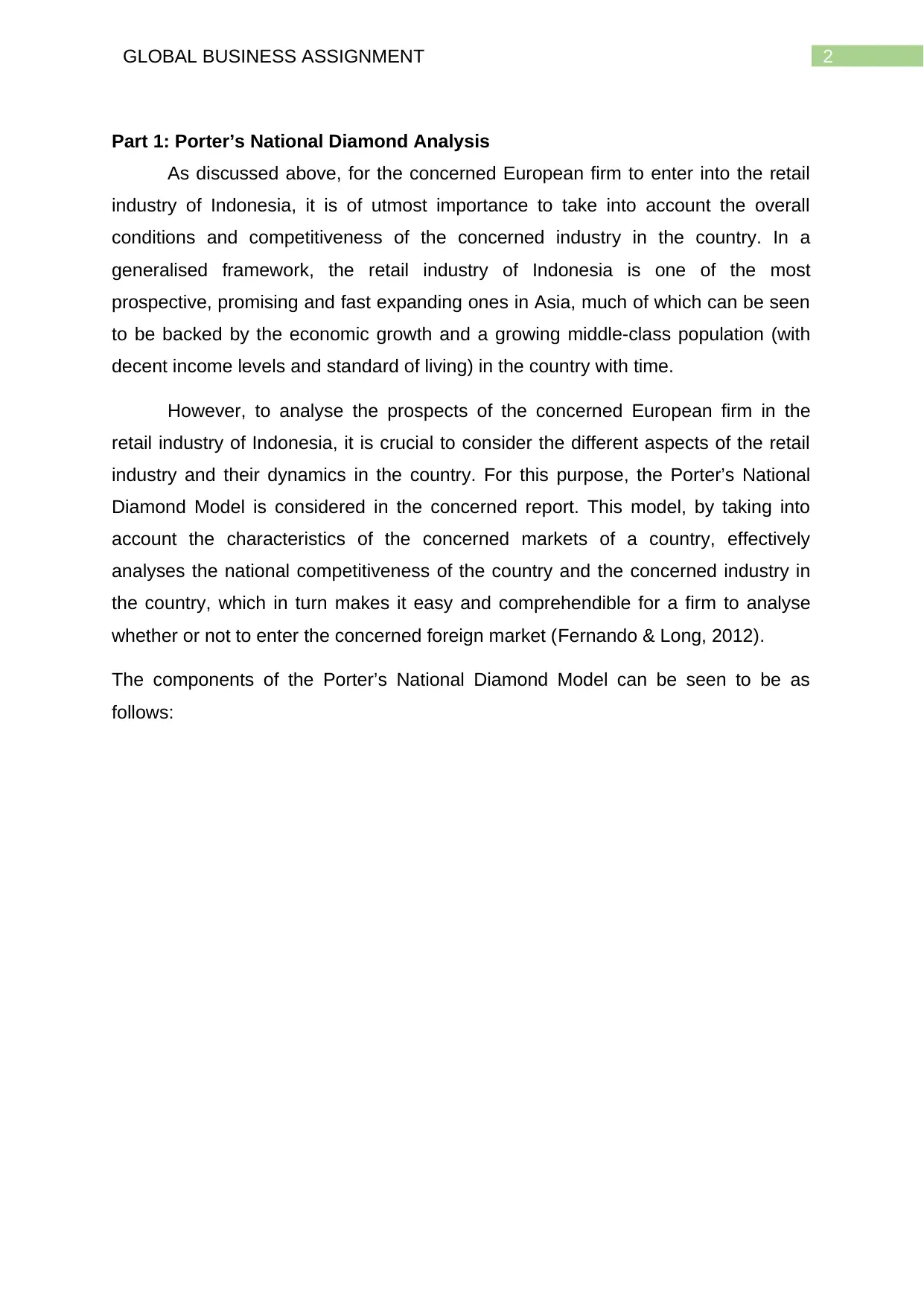
2GLOBAL BUSINESS ASSIGNMENT
Part 1: Porter’s National Diamond Analysis
As discussed above, for the concerned European firm to enter into the retail
industry of Indonesia, it is of utmost importance to take into account the overall
conditions and competitiveness of the concerned industry in the country. In a
generalised framework, the retail industry of Indonesia is one of the most
prospective, promising and fast expanding ones in Asia, much of which can be seen
to be backed by the economic growth and a growing middle-class population (with
decent income levels and standard of living) in the country with time.
However, to analyse the prospects of the concerned European firm in the
retail industry of Indonesia, it is crucial to consider the different aspects of the retail
industry and their dynamics in the country. For this purpose, the Porter’s National
Diamond Model is considered in the concerned report. This model, by taking into
account the characteristics of the concerned markets of a country, effectively
analyses the national competitiveness of the country and the concerned industry in
the country, which in turn makes it easy and comprehendible for a firm to analyse
whether or not to enter the concerned foreign market (Fernando & Long, 2012).
The components of the Porter’s National Diamond Model can be seen to be as
follows:
Part 1: Porter’s National Diamond Analysis
As discussed above, for the concerned European firm to enter into the retail
industry of Indonesia, it is of utmost importance to take into account the overall
conditions and competitiveness of the concerned industry in the country. In a
generalised framework, the retail industry of Indonesia is one of the most
prospective, promising and fast expanding ones in Asia, much of which can be seen
to be backed by the economic growth and a growing middle-class population (with
decent income levels and standard of living) in the country with time.
However, to analyse the prospects of the concerned European firm in the
retail industry of Indonesia, it is crucial to consider the different aspects of the retail
industry and their dynamics in the country. For this purpose, the Porter’s National
Diamond Model is considered in the concerned report. This model, by taking into
account the characteristics of the concerned markets of a country, effectively
analyses the national competitiveness of the country and the concerned industry in
the country, which in turn makes it easy and comprehendible for a firm to analyse
whether or not to enter the concerned foreign market (Fernando & Long, 2012).
The components of the Porter’s National Diamond Model can be seen to be as
follows:
⊘ This is a preview!⊘
Do you want full access?
Subscribe today to unlock all pages.

Trusted by 1+ million students worldwide
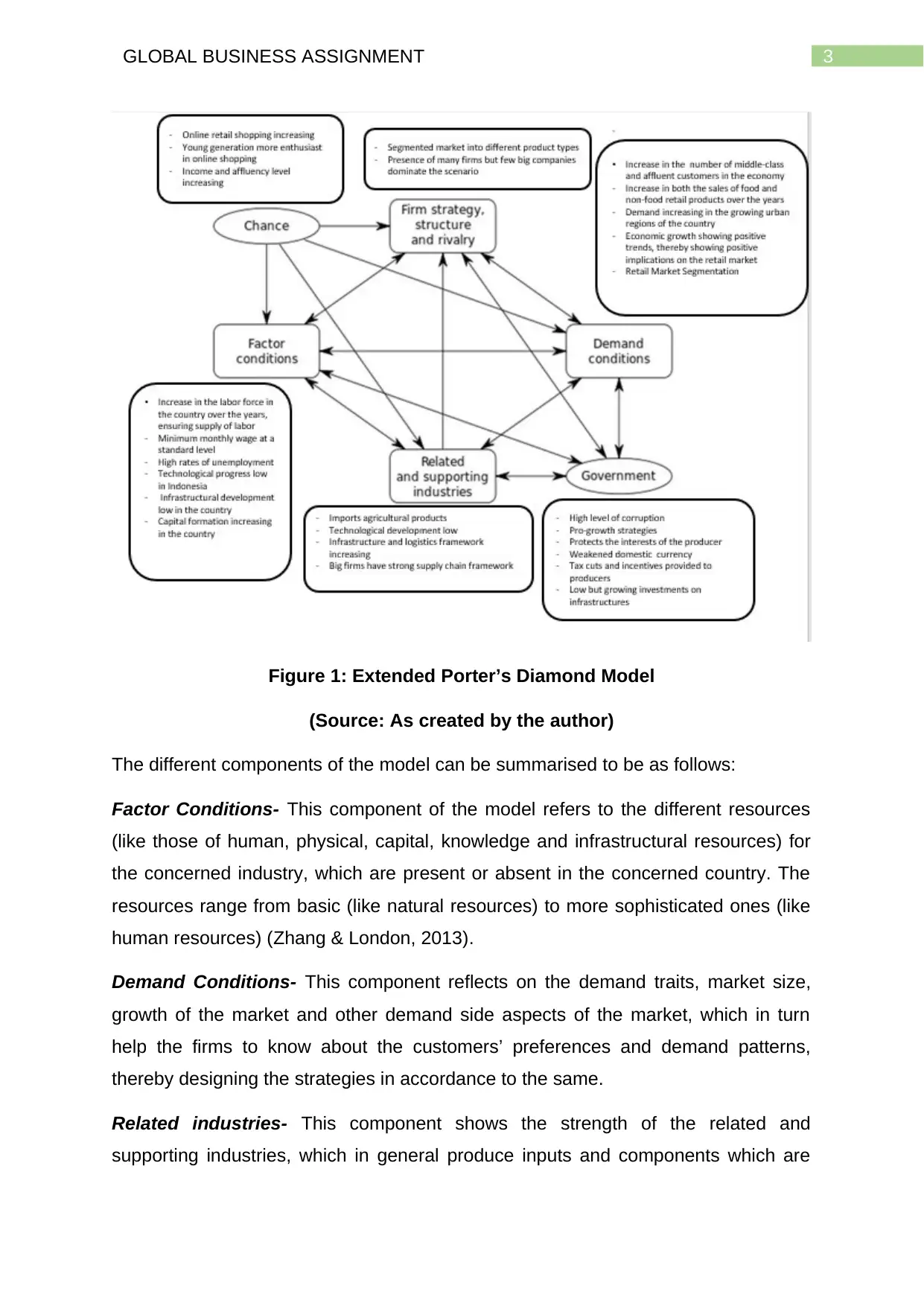
3GLOBAL BUSINESS ASSIGNMENT
Figure 1: Extended Porter’s Diamond Model
(Source: As created by the author)
The different components of the model can be summarised to be as follows:
Factor Conditions- This component of the model refers to the different resources
(like those of human, physical, capital, knowledge and infrastructural resources) for
the concerned industry, which are present or absent in the concerned country. The
resources range from basic (like natural resources) to more sophisticated ones (like
human resources) (Zhang & London, 2013).
Demand Conditions- This component reflects on the demand traits, market size,
growth of the market and other demand side aspects of the market, which in turn
help the firms to know about the customers’ preferences and demand patterns,
thereby designing the strategies in accordance to the same.
Related industries- This component shows the strength of the related and
supporting industries, which in general produce inputs and components which are
Figure 1: Extended Porter’s Diamond Model
(Source: As created by the author)
The different components of the model can be summarised to be as follows:
Factor Conditions- This component of the model refers to the different resources
(like those of human, physical, capital, knowledge and infrastructural resources) for
the concerned industry, which are present or absent in the concerned country. The
resources range from basic (like natural resources) to more sophisticated ones (like
human resources) (Zhang & London, 2013).
Demand Conditions- This component reflects on the demand traits, market size,
growth of the market and other demand side aspects of the market, which in turn
help the firms to know about the customers’ preferences and demand patterns,
thereby designing the strategies in accordance to the same.
Related industries- This component shows the strength of the related and
supporting industries, which in general produce inputs and components which are
Paraphrase This Document
Need a fresh take? Get an instant paraphrase of this document with our AI Paraphraser

4GLOBAL BUSINESS ASSIGNMENT
significant for the innovation and internationalization of the concerned industry, by
contributing to the efficiency and cost-effectiveness of the industries.
Firm Strategy, rivalry and structure- This reflects the organization and
management of the companies and also shows the nature of rivalry in the market of
the concerned country, which in turn helps the new companies to estimate the level
of competition and operational framework present in an industry, thereby designing
their strategies according to the same (Huggins & Izushi, 2015).
Government- The business frameworks in a country, in general, are influenced by
the government of a country and the regulations provided by the same, which have
the chance to influence all the other components of the Porter’s Diamond Model. The
actions of the government can have positive, negative or no implications at all
(Fainshmidt, Smith & Judge, 2016).
Chance- This component of the model, takes into account the random events which
are not in the control of the company but which have considerable implications on
the international competitiveness (both positive as well as negative) of the industry in
the country taken into consideration.
Keeping this into consideration, the Porter’s Diamond Model is applied to the
Indonesian retail market in the following section of the report, to analyse the
prospects which are present in the market and the problems which the new firm,
aiming to venture in the market can experience.
Porter’s Diamond Model: Indonesian Retail Market
As discussed above, the retail market of Indonesia can be seen to be
expanding over the years, emerging as one of the fastest growing one in the whole
Asia. The primary reason behind the growth of the market in the country can be
attributed to the large population of a growing middle class in the country, with a
change in the modern spending habits. The different trends of the retail industry of
Indonesia, can be analysed with the help of the different components of the Porter’s
Diamond Model, which is as follows:
1. Demand Conditions in the Retail Industry of Indonesia
The retail industry of the country, in spite of being one of the most dynamic in
the whole of Asia, can be seen to have mixed growth patterns in the contemporary
significant for the innovation and internationalization of the concerned industry, by
contributing to the efficiency and cost-effectiveness of the industries.
Firm Strategy, rivalry and structure- This reflects the organization and
management of the companies and also shows the nature of rivalry in the market of
the concerned country, which in turn helps the new companies to estimate the level
of competition and operational framework present in an industry, thereby designing
their strategies according to the same (Huggins & Izushi, 2015).
Government- The business frameworks in a country, in general, are influenced by
the government of a country and the regulations provided by the same, which have
the chance to influence all the other components of the Porter’s Diamond Model. The
actions of the government can have positive, negative or no implications at all
(Fainshmidt, Smith & Judge, 2016).
Chance- This component of the model, takes into account the random events which
are not in the control of the company but which have considerable implications on
the international competitiveness (both positive as well as negative) of the industry in
the country taken into consideration.
Keeping this into consideration, the Porter’s Diamond Model is applied to the
Indonesian retail market in the following section of the report, to analyse the
prospects which are present in the market and the problems which the new firm,
aiming to venture in the market can experience.
Porter’s Diamond Model: Indonesian Retail Market
As discussed above, the retail market of Indonesia can be seen to be
expanding over the years, emerging as one of the fastest growing one in the whole
Asia. The primary reason behind the growth of the market in the country can be
attributed to the large population of a growing middle class in the country, with a
change in the modern spending habits. The different trends of the retail industry of
Indonesia, can be analysed with the help of the different components of the Porter’s
Diamond Model, which is as follows:
1. Demand Conditions in the Retail Industry of Indonesia
The retail industry of the country, in spite of being one of the most dynamic in
the whole of Asia, can be seen to have mixed growth patterns in the contemporary
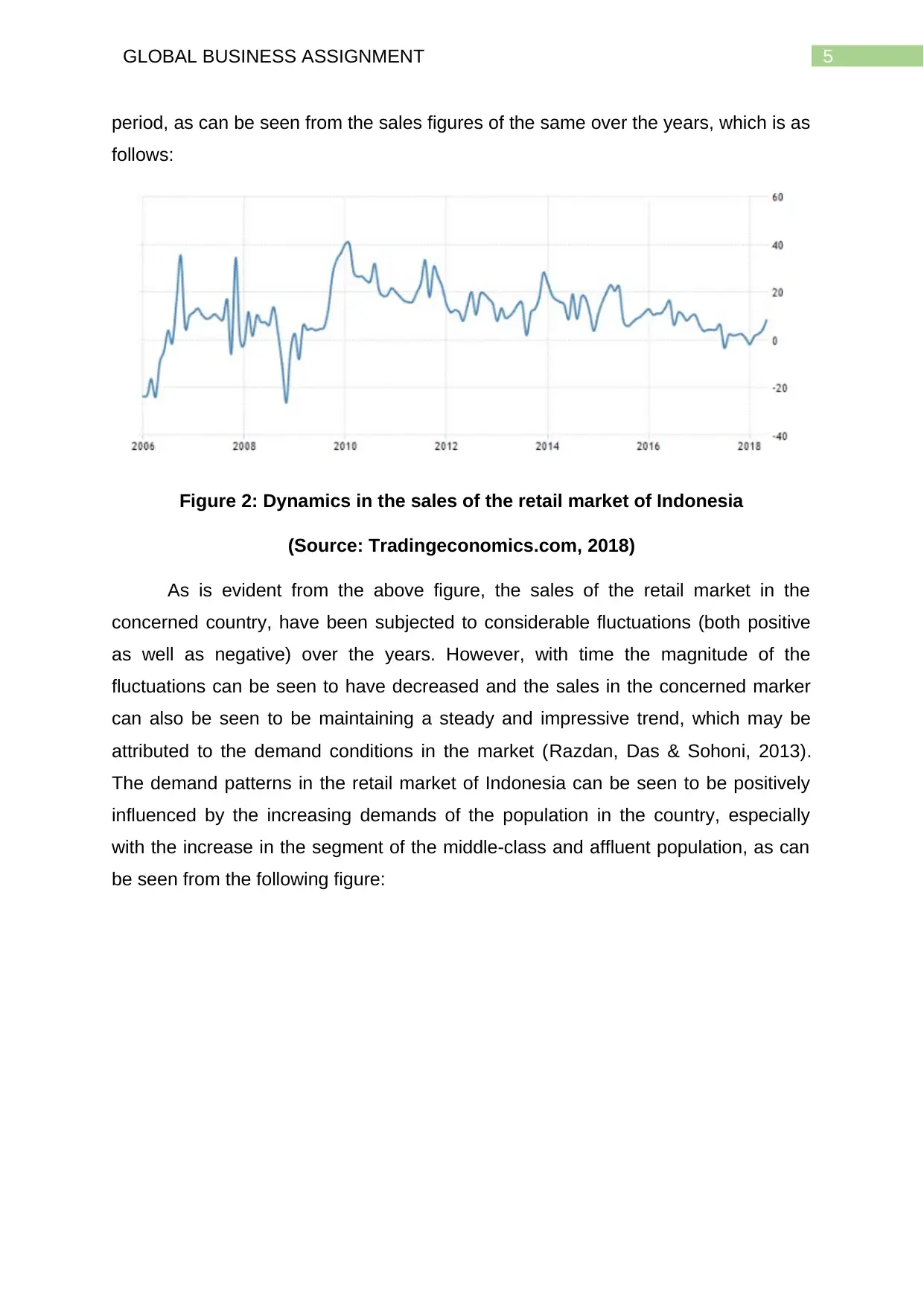
5GLOBAL BUSINESS ASSIGNMENT
period, as can be seen from the sales figures of the same over the years, which is as
follows:
Figure 2: Dynamics in the sales of the retail market of Indonesia
(Source: Tradingeconomics.com, 2018)
As is evident from the above figure, the sales of the retail market in the
concerned country, have been subjected to considerable fluctuations (both positive
as well as negative) over the years. However, with time the magnitude of the
fluctuations can be seen to have decreased and the sales in the concerned marker
can also be seen to be maintaining a steady and impressive trend, which may be
attributed to the demand conditions in the market (Razdan, Das & Sohoni, 2013).
The demand patterns in the retail market of Indonesia can be seen to be positively
influenced by the increasing demands of the population in the country, especially
with the increase in the segment of the middle-class and affluent population, as can
be seen from the following figure:
period, as can be seen from the sales figures of the same over the years, which is as
follows:
Figure 2: Dynamics in the sales of the retail market of Indonesia
(Source: Tradingeconomics.com, 2018)
As is evident from the above figure, the sales of the retail market in the
concerned country, have been subjected to considerable fluctuations (both positive
as well as negative) over the years. However, with time the magnitude of the
fluctuations can be seen to have decreased and the sales in the concerned marker
can also be seen to be maintaining a steady and impressive trend, which may be
attributed to the demand conditions in the market (Razdan, Das & Sohoni, 2013).
The demand patterns in the retail market of Indonesia can be seen to be positively
influenced by the increasing demands of the population in the country, especially
with the increase in the segment of the middle-class and affluent population, as can
be seen from the following figure:
⊘ This is a preview!⊘
Do you want full access?
Subscribe today to unlock all pages.

Trusted by 1+ million students worldwide
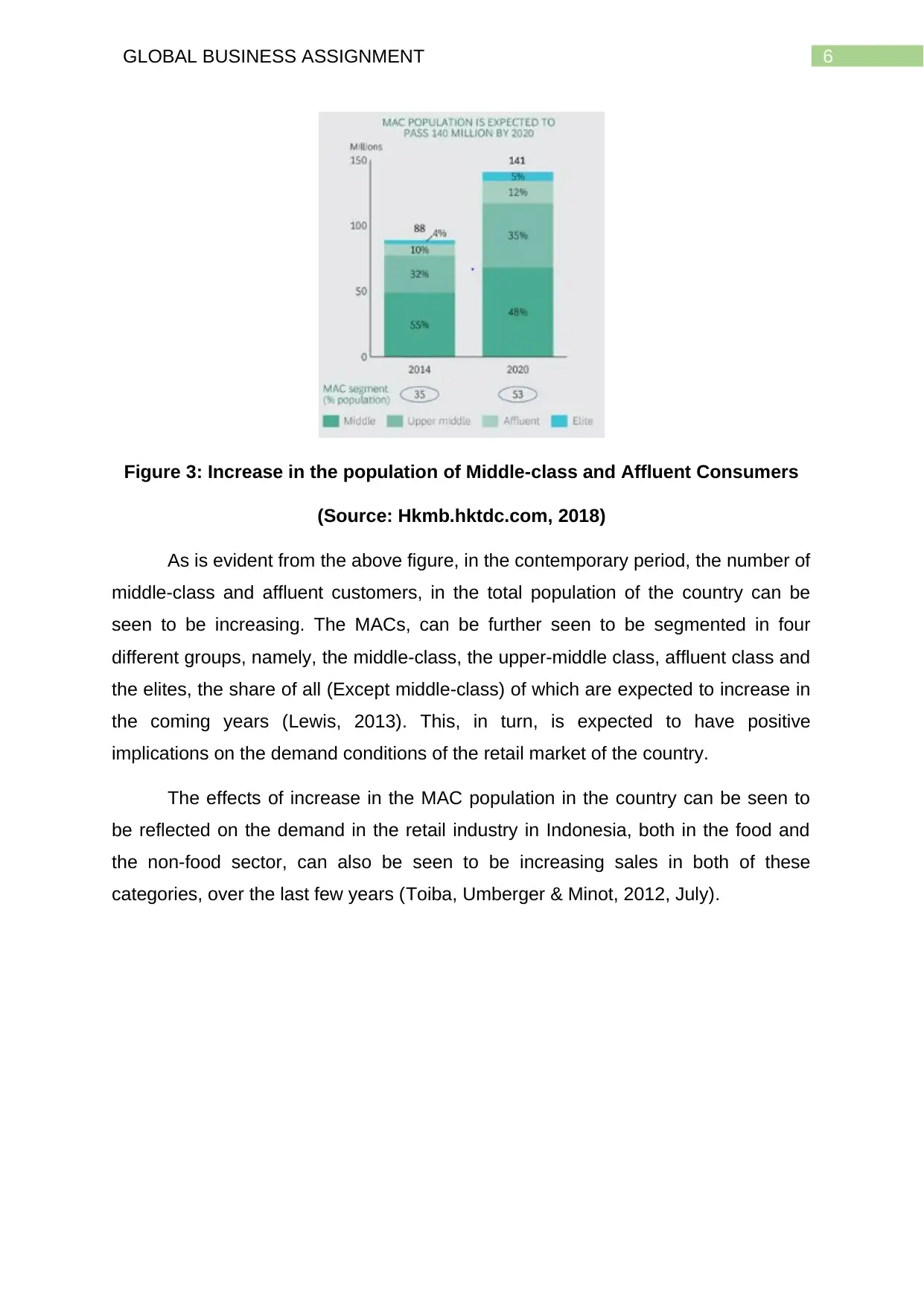
6GLOBAL BUSINESS ASSIGNMENT
Figure 3: Increase in the population of Middle-class and Affluent Consumers
(Source: Hkmb.hktdc.com, 2018)
As is evident from the above figure, in the contemporary period, the number of
middle-class and affluent customers, in the total population of the country can be
seen to be increasing. The MACs, can be further seen to be segmented in four
different groups, namely, the middle-class, the upper-middle class, affluent class and
the elites, the share of all (Except middle-class) of which are expected to increase in
the coming years (Lewis, 2013). This, in turn, is expected to have positive
implications on the demand conditions of the retail market of the country.
The effects of increase in the MAC population in the country can be seen to
be reflected on the demand in the retail industry in Indonesia, both in the food and
the non-food sector, can also be seen to be increasing sales in both of these
categories, over the last few years (Toiba, Umberger & Minot, 2012, July).
Figure 3: Increase in the population of Middle-class and Affluent Consumers
(Source: Hkmb.hktdc.com, 2018)
As is evident from the above figure, in the contemporary period, the number of
middle-class and affluent customers, in the total population of the country can be
seen to be increasing. The MACs, can be further seen to be segmented in four
different groups, namely, the middle-class, the upper-middle class, affluent class and
the elites, the share of all (Except middle-class) of which are expected to increase in
the coming years (Lewis, 2013). This, in turn, is expected to have positive
implications on the demand conditions of the retail market of the country.
The effects of increase in the MAC population in the country can be seen to
be reflected on the demand in the retail industry in Indonesia, both in the food and
the non-food sector, can also be seen to be increasing sales in both of these
categories, over the last few years (Toiba, Umberger & Minot, 2012, July).
Paraphrase This Document
Need a fresh take? Get an instant paraphrase of this document with our AI Paraphraser
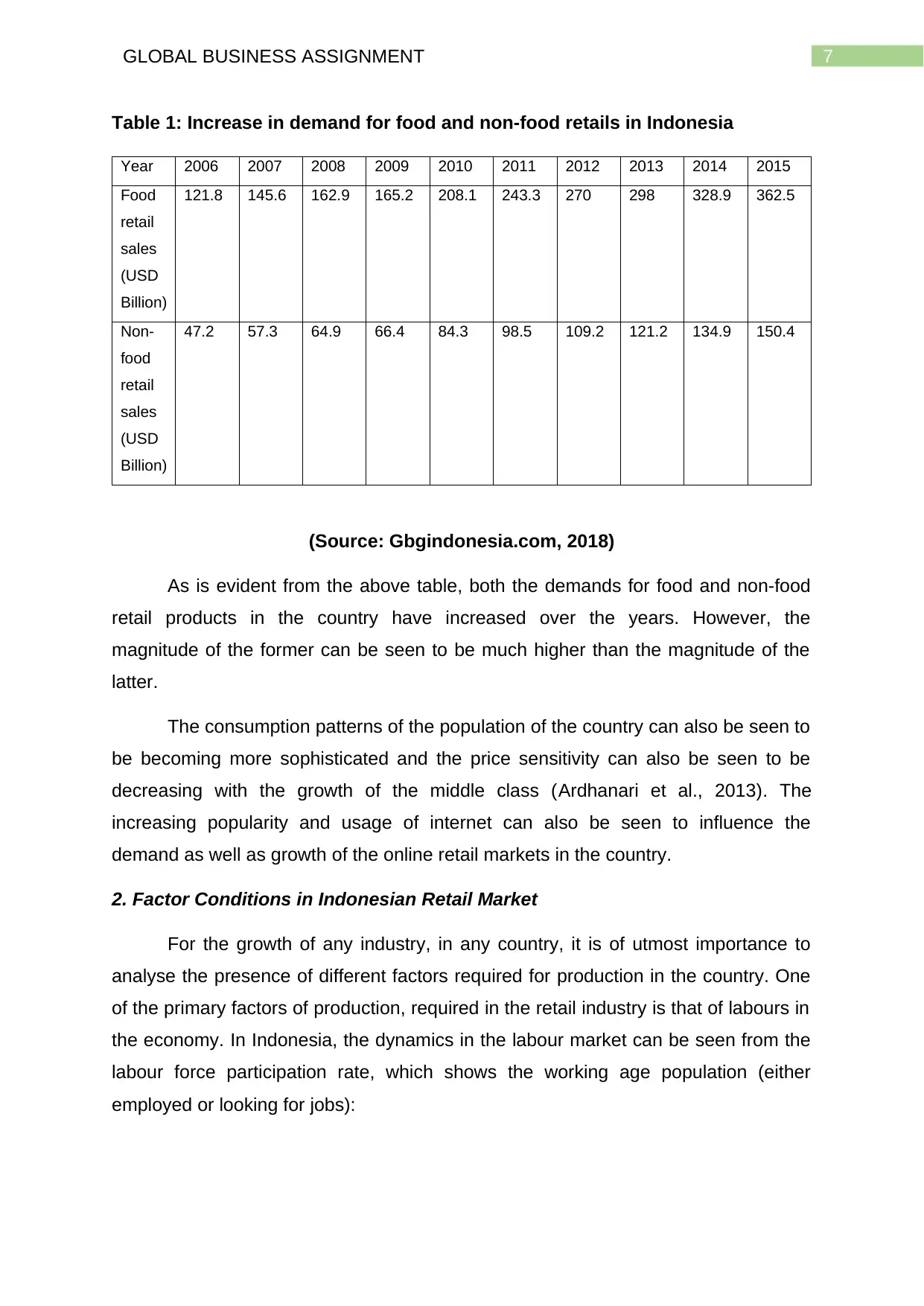
7GLOBAL BUSINESS ASSIGNMENT
Table 1: Increase in demand for food and non-food retails in Indonesia
Year 2006 2007 2008 2009 2010 2011 2012 2013 2014 2015
Food
retail
sales
(USD
Billion)
121.8 145.6 162.9 165.2 208.1 243.3 270 298 328.9 362.5
Non-
food
retail
sales
(USD
Billion)
47.2 57.3 64.9 66.4 84.3 98.5 109.2 121.2 134.9 150.4
(Source: Gbgindonesia.com, 2018)
As is evident from the above table, both the demands for food and non-food
retail products in the country have increased over the years. However, the
magnitude of the former can be seen to be much higher than the magnitude of the
latter.
The consumption patterns of the population of the country can also be seen to
be becoming more sophisticated and the price sensitivity can also be seen to be
decreasing with the growth of the middle class (Ardhanari et al., 2013). The
increasing popularity and usage of internet can also be seen to influence the
demand as well as growth of the online retail markets in the country.
2. Factor Conditions in Indonesian Retail Market
For the growth of any industry, in any country, it is of utmost importance to
analyse the presence of different factors required for production in the country. One
of the primary factors of production, required in the retail industry is that of labours in
the economy. In Indonesia, the dynamics in the labour market can be seen from the
labour force participation rate, which shows the working age population (either
employed or looking for jobs):
Table 1: Increase in demand for food and non-food retails in Indonesia
Year 2006 2007 2008 2009 2010 2011 2012 2013 2014 2015
Food
retail
sales
(USD
Billion)
121.8 145.6 162.9 165.2 208.1 243.3 270 298 328.9 362.5
Non-
food
retail
sales
(USD
Billion)
47.2 57.3 64.9 66.4 84.3 98.5 109.2 121.2 134.9 150.4
(Source: Gbgindonesia.com, 2018)
As is evident from the above table, both the demands for food and non-food
retail products in the country have increased over the years. However, the
magnitude of the former can be seen to be much higher than the magnitude of the
latter.
The consumption patterns of the population of the country can also be seen to
be becoming more sophisticated and the price sensitivity can also be seen to be
decreasing with the growth of the middle class (Ardhanari et al., 2013). The
increasing popularity and usage of internet can also be seen to influence the
demand as well as growth of the online retail markets in the country.
2. Factor Conditions in Indonesian Retail Market
For the growth of any industry, in any country, it is of utmost importance to
analyse the presence of different factors required for production in the country. One
of the primary factors of production, required in the retail industry is that of labours in
the economy. In Indonesia, the dynamics in the labour market can be seen from the
labour force participation rate, which shows the working age population (either
employed or looking for jobs):

8GLOBAL BUSINESS ASSIGNMENT
Figure 4: Labour Force Participation Rate in Indonesia
(Source: Tradingeconomics.com, 2018)
The section of population, eligible to work, can be seen to be drastically
increasing in Indonesia post 1996 and the share can be seen to be consistently
remining high in the current periods, which in turn indicates towards the presence of
labour in the economy (Reardon, Timmer & Minten, 2012).
Figure 5: Minimum monthly wage in Indonesia
(Source: Tradingeconomics.com, 2018)
Although the minimum wage of the country can be seen to be increasing and
currently at a standard level. however, with the increase in the labour supply, often
the actual labour rates can be seen to be existing at lower levels than the minimum
wage rates in the economy, especially in industries like retail industries, where the
labour required are mostly those with basic skills (Khamis, 2013).
Figure 4: Labour Force Participation Rate in Indonesia
(Source: Tradingeconomics.com, 2018)
The section of population, eligible to work, can be seen to be drastically
increasing in Indonesia post 1996 and the share can be seen to be consistently
remining high in the current periods, which in turn indicates towards the presence of
labour in the economy (Reardon, Timmer & Minten, 2012).
Figure 5: Minimum monthly wage in Indonesia
(Source: Tradingeconomics.com, 2018)
Although the minimum wage of the country can be seen to be increasing and
currently at a standard level. however, with the increase in the labour supply, often
the actual labour rates can be seen to be existing at lower levels than the minimum
wage rates in the economy, especially in industries like retail industries, where the
labour required are mostly those with basic skills (Khamis, 2013).
⊘ This is a preview!⊘
Do you want full access?
Subscribe today to unlock all pages.

Trusted by 1+ million students worldwide

9GLOBAL BUSINESS ASSIGNMENT
Apart from the labour resources, the country can also be seen to be
experiencing increase in the capital formation in the present years, which can be
seen to be as follows:
Figure 6: Gross Fixed Capital Formation in Indonesia
(Source: Tradingeconomics.com, 2018)
This indicates towards the increase in capital resources in the country, which
can also be considered to be having favourable impacts on the industries of the
country, including the retail industry of Indonesia.
However, the country lacks in terms of infrastructural development, both in
terms of hard infrastructure (like roads, airports) as well as soft infrastructure (social
welfare and healthcare), as can be seen from its moderate rank (62nd out of 140
economies) in terms of global infrastructural development as can be found in the
Global Competitive Report of World Economic Forum.
3. Firm Strategy, Rivalry and Structure
The structure of the retail industry of Indonesia, can be segmented in terms of
product category, to be as follows:
Food and beverages
Apparel and footwears
Consumer electronics
Beauty and care products
Home appliances and improvement products
Apart from the labour resources, the country can also be seen to be
experiencing increase in the capital formation in the present years, which can be
seen to be as follows:
Figure 6: Gross Fixed Capital Formation in Indonesia
(Source: Tradingeconomics.com, 2018)
This indicates towards the increase in capital resources in the country, which
can also be considered to be having favourable impacts on the industries of the
country, including the retail industry of Indonesia.
However, the country lacks in terms of infrastructural development, both in
terms of hard infrastructure (like roads, airports) as well as soft infrastructure (social
welfare and healthcare), as can be seen from its moderate rank (62nd out of 140
economies) in terms of global infrastructural development as can be found in the
Global Competitive Report of World Economic Forum.
3. Firm Strategy, Rivalry and Structure
The structure of the retail industry of Indonesia, can be segmented in terms of
product category, to be as follows:
Food and beverages
Apparel and footwears
Consumer electronics
Beauty and care products
Home appliances and improvement products
Paraphrase This Document
Need a fresh take? Get an instant paraphrase of this document with our AI Paraphraser
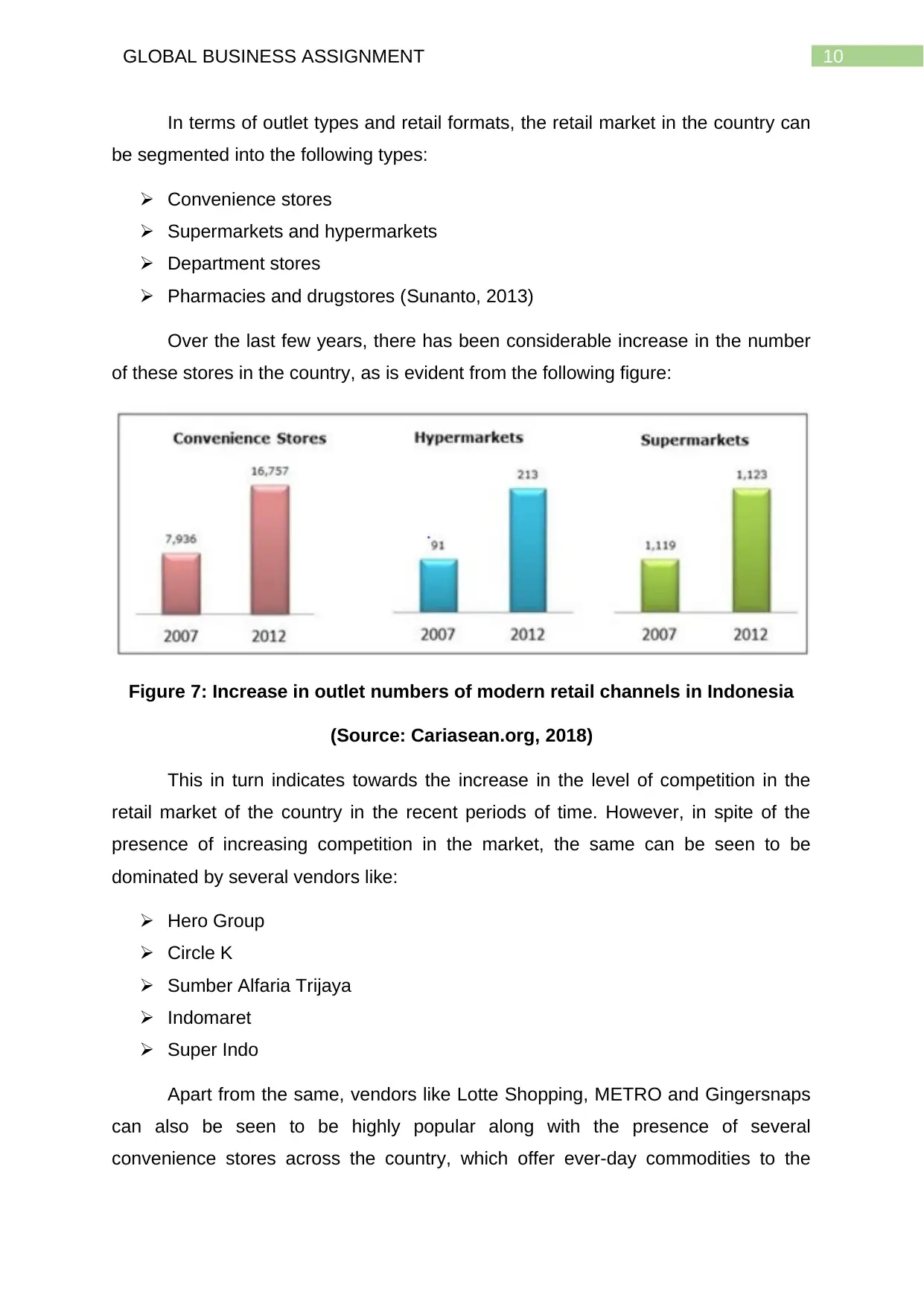
10GLOBAL BUSINESS ASSIGNMENT
In terms of outlet types and retail formats, the retail market in the country can
be segmented into the following types:
Convenience stores
Supermarkets and hypermarkets
Department stores
Pharmacies and drugstores (Sunanto, 2013)
Over the last few years, there has been considerable increase in the number
of these stores in the country, as is evident from the following figure:
Figure 7: Increase in outlet numbers of modern retail channels in Indonesia
(Source: Cariasean.org, 2018)
This in turn indicates towards the increase in the level of competition in the
retail market of the country in the recent periods of time. However, in spite of the
presence of increasing competition in the market, the same can be seen to be
dominated by several vendors like:
Hero Group
Circle K
Sumber Alfaria Trijaya
Indomaret
Super Indo
Apart from the same, vendors like Lotte Shopping, METRO and Gingersnaps
can also be seen to be highly popular along with the presence of several
convenience stores across the country, which offer ever-day commodities to the
In terms of outlet types and retail formats, the retail market in the country can
be segmented into the following types:
Convenience stores
Supermarkets and hypermarkets
Department stores
Pharmacies and drugstores (Sunanto, 2013)
Over the last few years, there has been considerable increase in the number
of these stores in the country, as is evident from the following figure:
Figure 7: Increase in outlet numbers of modern retail channels in Indonesia
(Source: Cariasean.org, 2018)
This in turn indicates towards the increase in the level of competition in the
retail market of the country in the recent periods of time. However, in spite of the
presence of increasing competition in the market, the same can be seen to be
dominated by several vendors like:
Hero Group
Circle K
Sumber Alfaria Trijaya
Indomaret
Super Indo
Apart from the same, vendors like Lotte Shopping, METRO and Gingersnaps
can also be seen to be highly popular along with the presence of several
convenience stores across the country, which offer ever-day commodities to the

11GLOBAL BUSINESS ASSIGNMENT
customers. Apart from the same, many international companies can also be seen to
be venturing in the market, especially in the era of increasing popularity of online
retailing in the industry (Howard, 2013). The companies venturing in the market,
especially the big and dominating ones can be seen to be highly structured and
organized in their operational framework and they also differ in terms of their
ownership, thereby adding diversity to the retail market in the industry.
4. Government
The government of Indonesia, although being not that actively involved in the
operations of the retail industry of the country, however, tend to influence the same
to a considerable extent, primarily due to the regulations imposed by the same in the
economy in general. While the weakening of the rupiah can be seen to have
negative impacts on the disposable income of the population of the country, thereby
affecting the retail industry, especially the traditional retail companies negatively, the
same can be seen to be combated to a considerable extent by the assistance
programmes launched by the government, especially for the lower income groups,
which in turn has facilitated to keep the demands for food retail products afloat
(Poynter, 2013).
The government of the country also has implemented several pro-growth
policies to draw foreign direct investments in the country and to attract companies
from all parts of the globe to boost up both the production as well as the overall
demand in the economy (Poynter, 2013). These primarily include the tax cuts and
amnesties which are to a considerable extent favourable to the growth of the retail
industry in the country.
However, the government of the country does not seem to have emphasised
on the development of the infrastructures in the country, due to which the country
and its industries tend to suffer in terms of both hard and soft infrastructure.
However, in the recent periods, this issue seems to be taken seriously by the
government, as can be seen from the increasing funds allocated by the same in this
domain:
customers. Apart from the same, many international companies can also be seen to
be venturing in the market, especially in the era of increasing popularity of online
retailing in the industry (Howard, 2013). The companies venturing in the market,
especially the big and dominating ones can be seen to be highly structured and
organized in their operational framework and they also differ in terms of their
ownership, thereby adding diversity to the retail market in the industry.
4. Government
The government of Indonesia, although being not that actively involved in the
operations of the retail industry of the country, however, tend to influence the same
to a considerable extent, primarily due to the regulations imposed by the same in the
economy in general. While the weakening of the rupiah can be seen to have
negative impacts on the disposable income of the population of the country, thereby
affecting the retail industry, especially the traditional retail companies negatively, the
same can be seen to be combated to a considerable extent by the assistance
programmes launched by the government, especially for the lower income groups,
which in turn has facilitated to keep the demands for food retail products afloat
(Poynter, 2013).
The government of the country also has implemented several pro-growth
policies to draw foreign direct investments in the country and to attract companies
from all parts of the globe to boost up both the production as well as the overall
demand in the economy (Poynter, 2013). These primarily include the tax cuts and
amnesties which are to a considerable extent favourable to the growth of the retail
industry in the country.
However, the government of the country does not seem to have emphasised
on the development of the infrastructures in the country, due to which the country
and its industries tend to suffer in terms of both hard and soft infrastructure.
However, in the recent periods, this issue seems to be taken seriously by the
government, as can be seen from the increasing funds allocated by the same in this
domain:
⊘ This is a preview!⊘
Do you want full access?
Subscribe today to unlock all pages.

Trusted by 1+ million students worldwide
1 out of 22
Related Documents
Your All-in-One AI-Powered Toolkit for Academic Success.
+13062052269
info@desklib.com
Available 24*7 on WhatsApp / Email
![[object Object]](/_next/static/media/star-bottom.7253800d.svg)
Unlock your academic potential
Copyright © 2020–2025 A2Z Services. All Rights Reserved. Developed and managed by ZUCOL.





